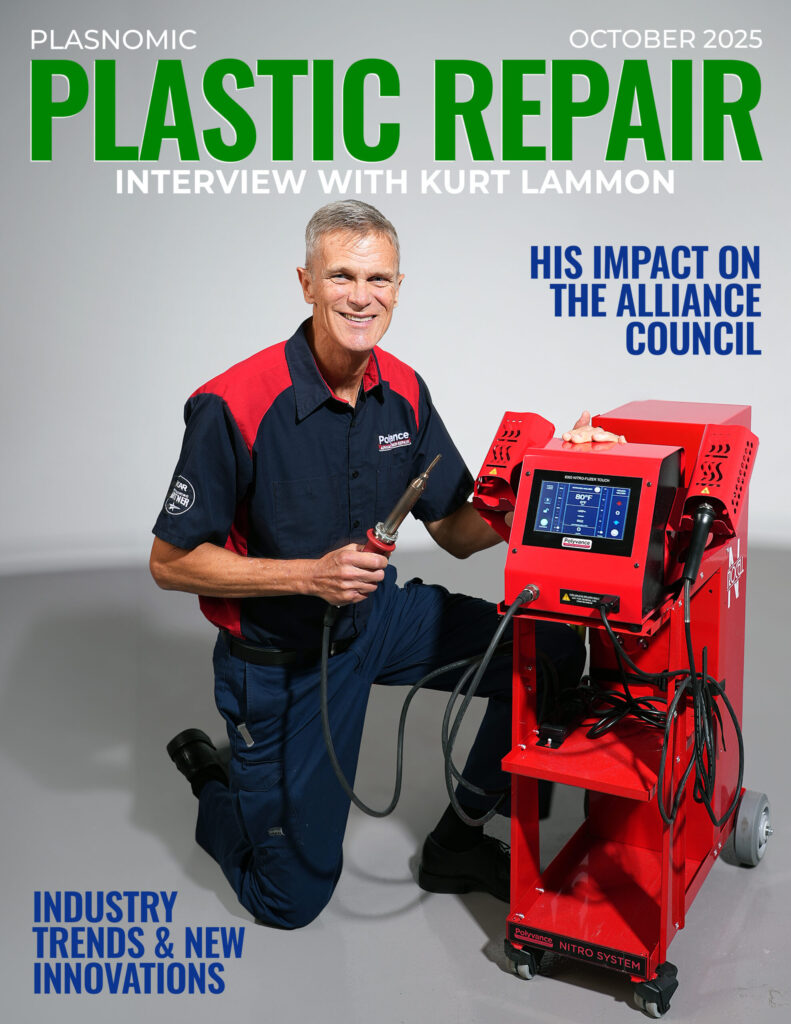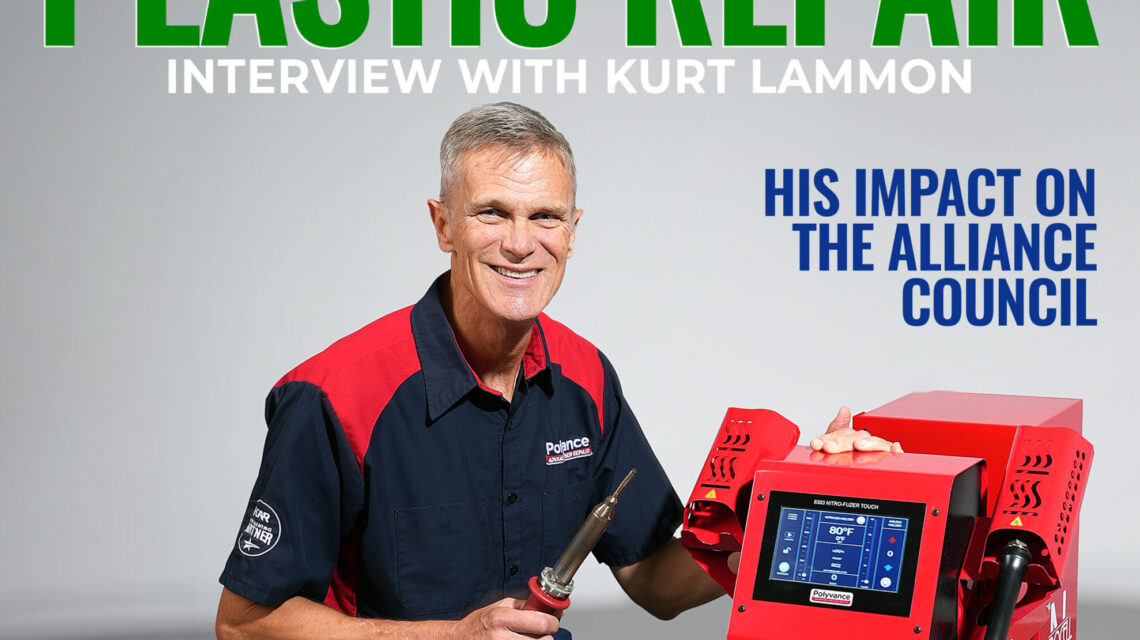
“Shaping the Future of Plastic Repair”
Introduction:
For decades, Kurt Lammon, President of Polyvance, has been a respected leader in the evolution of plastic repair technologies across the collision repair industry. A long-time advocate for education, innovation, and a repair-first mindset, Kurt has witnessed firsthand how the industry has transformed—and where it still needs to go.
In this exclusive interview, Kurt shares his insights on the current state of plastic repair, the importance of using the right tools and equipment, the growing demand for skilled technicians, and the critical need for unified global standards that can guide the industry toward a more sustainable and efficient future.
Q&A Interview
Q1. Kurt, you’ve been in the plastic repair space for a long time. How would you describe the journey of plastic repair in the collision industry from where it started to where it stands today?
Yes, thirty years now! When I started in the industry in 1995, Polyvance (then called Urethane Supply Company) sold a lot of product to bumper recycling companies. In that era, not too far removed from the old chrome bumper days, plastic repair was still considered somewhat of a black art in body shops, so the old chrome bumper recyclers, to survive in the new age, became expert at repairing plastic bumper covers and still swapped out damaged cores for repaired covers, just like they did with steel bumpers.
Of course, in the 90’s, most of the domestic cars had polyurethane covers, and the Japanese imports were transitioning to polypropylene. We lamented the transition away from urethane as that old “yellow plastic” was quite easy to repair with the airless plastic welder, and the polypropylene and TPO covers were more difficult. But since we introduced nitrogen plastic welding to the industry in 2006, PP/TPO became easy to repair with full confidence in its strength.
The OEMs price-matched recycled and aftermarket covers during the 2009 recession, decimating our bumper recycling customers, forcing most into bankruptcy. In 2011, we pioneered our nitrogen plastic welding technology in the body shops and had very good success. With nitrogen welding, body shops could have confidence in the quality of the repairs they made on all types of plastic, so that technology combined with Polyvance’s industry-leading, I-CAR-affiliated training brought plastic repair to a new level of acceptance.
Q2. What key changes have you noticed in how repairers and manufacturers view plastic components, particularly as more advanced materials and composites enter the market?
The perspective of repairers and manufacturers are so completely different, let’s discuss each in turn. From the OEM’s perspective, their main concern in the design of any component is to minimize cost and weight. After that, they want to consolidate parts to reduce parts count and speed assembly. Thankfully, advances in plastic composites and injection molding technology have enabled such things as single-piece radiator supports and full tailgates being molded of TPO. You’d think that the expansion of plastics into higher-value assemblies would make their repair more important, but there’s a common perception that OEMs prefer that shops replace damaged plastic components rather than repair them because crash parts are profitable for them and their dealer base.
From the repairer’s perspective, plastic repair still has an image of being somewhat of a red-headed stepchild. Since most plastic parts are non-structural, obviously it’s not as important in the grand scheme of things that they be repaired in comparison to structural components such as frame rails and door rings. Shops make huge investments in equipment and training so that they’re able to repair the vehicle’s structure adequately.
So, there’s always been a reflex to replace damaged plastic parts rather than repair them. This would make sense if all plastic parts cost less than $100, but the fact is, many plastic parts, such as today’s headlight assemblies, cost many thousands of dollars. Even though these parts are not structural, the cost to replace expensive plastic parts contributes to ballooning repair costs and even to repairable vehicles going over the total loss threshold.
That’s not to mention the environmental impact of repairable plastic parts being tossed into the landfill. That’s a negative for society at large, not just for us today but for generations to come.
Q3. There’s a growing industry push to prioritize repair over replacement. From your perspective, how does plastic repair fit into both the financial and sustainability movements for repairers, insurers, and consumers?
I’m glad to see Plasnomic pushing the conversation forward about plastic repair. Plastic parts are only going to become more prevalent as the OEMs continue to pursue cost reductions and part consolidations, so the motivation to repair damaged plastics is always going to be there and will probably accelerate as their cost increases.
At Polyvance, we understand that it doesn’t make sense to repair every damaged plastic part. It needs to be a win-win-win for the consumer, shop, technician, and bill-payer. It’s hard to convince a shop to do a plastic repair when they could make more money replacing the part. Therefore, insurers need to incentivize repair by finding a price point where both parties win.
Doing more plastic repairs will help bring down total severity and, in the long run, take pressure off the relentless increase in insurance premiums which are hurting consumers. The increase in premiums and deductibles is causing more consumers to pay out of pocket for repairs. From my research, somewhere between 20-25% of all repairs are self-pay today. Shops that do plastic repairs can save these self-pay customers a lot of money and engender some goodwill in the process. And in all cases, any part that gets repaired is a part that doesn’t go in the landfill to sit for the next thousand years.
Q4. The Plasnomic Council is working toward establishing global standards for plastic repair. Why do you believe it’s critical to have a unified framework or a “universal language” for plastic repair methods?
There has been a lot of innovation in plastic repair methods over the past thirty years, and innovation must continue as the OEMs introduce new plastic types and constructions. Ultimately, it’s the free market that determines winners and losers in any realm, and to the winner go the spoils, as they should.
So the only thing I would caution the Plasnomic Council on is to make sure any standards created don’t stifle innovation. As long as the approval process is transparent and the industry has trust in it, I feel that there is some benefit in having a “universal language” about plastic repair, especially among those in the industry who only occasionally interact with it. The state of the art in plastic repair will continue to evolve, and as long as the global standards are open to innovation and are updated accordingly, I think it will be a positive for the industry.
Q5. Training and certification remain at the heart of building technician confidence. In your view, what are the most important skills or principles every plastic repair technician should master today?
Polyvance has had formal training programs for plastic repair for over twenty years, so we’re very well attuned to the needs that technicians have. All our I-CAR Industry Training Alliance and Polyvance University courses follow a similar pattern–we first address the identification of the type of plastic being repaired. Of course, polypropylene and PP blends predominate, but there are at least a half-dozen others that are common. The optimal repair method – welding or adhesives depends on the plastic type, so it’s crucial to know that first.
After that, we’ll focus on proper cleaning and preparation of the repair area. Then the proper use of simple hand tools such as grinders and sanders. The depth and taper of a v-groove is very important for both the strength and appearance of the final outcome. The preparation for weld repairs and adhesive repairs is quite different, so we try to instill an understanding of why they differ.
Q6. From your experience, what does it take to truly change an industry’s behavior, especially one that has long favored replacement over repair?
Charlie Munger said, “show me the incentive and I’ll show you the outcome.” If bill-payers are going to continue to provide two hours of labor to repair the tab on a $2,000 headlight, it’ll be no surprise if the shops continue to covet that $500 of easy profit they can make on a replacement headlight. Also, if OEMs continue to have blanket bans on the repair of plastic bumper covers regardless of the location of the damage relative to the sensors, then that obviously quashes any possibility of repair on those parts.
Each party in the collision repair ecosystem could benefit from plastic repair, even the OEMs. I am hopeful that Plasnomic’s efforts to bring the disparate parties together and to elevate the issue of plastic repair beyond the parochial economic concerns of each will succeed.
Q7. Innovation continues to drive the evolution of our industry. Can you share some of Polyvance’s recent innovations and how they’ve helped advance plastic repair processes and outcomes?
At Polyvance, we’re proud to have pioneered nitrogen welding technology in the industry here in the US. Previously, polypropylene was difficult to repair because adhesives don’t stick well to it due to its low surface energy. Fusion welding with nitrogen gas is a faster, stronger, and less-expensive method. This innovation combined with our training helped us to put a nitrogen welder into roughly half the shops in America. Our equipment is used by thousands of shops on a daily basis, benefiting consumers, bill-payers, shops, and the environment.
Our product innovation team at Polyvance has over 75 years of combined experience in the field, and we get technical support calls directly from our end-user customers on a daily basis to keep us attuned to any future needs.
Q8. If you could send one message to shop owners and technicians about the future of plastic repair, what would it be?
Plastic parts are not going away, so don’t bury your head in the sand. Shops that can repair plastic will be able to provide more options to the consumer and bill-payer to reduce cost, which could drive more business to your shop. If you’re not doing it now, get some equipment and training. Practice makes perfect. You’ve got a whole pile of parts in the dumpster you can practice on. Start offering creative options to your self-pay customers first. As you gain experience and confidence, start offering repair options on insurance-paid jobs. Make sure your estimators know what skills your technicians have so they don’t automatically write for replacement on every damaged plastic part.
Q9. Finally, on a personal note what continues to motivate you about this work after so many years in the field?
The fact that Plastnomic has attracted attention from industry players all over the world tells me that there is still a big need for and opportunity in plastic repair. I’ve been in the industry for 30 years, so I’ve witnessed the continual evolution of plastic materials, products, processes, and needs as time has marched on. Change is the only constant, and all of us in the industry must continue to keep on top of the latest technology if we’re to thrive in the future, especially Polyvance, as we are focused exclusively on plastic repair and refinishing. We live and die by it, so our team here is maniacally focused on developing and commercializing the best products, methods, and training to help people repair and refinish damaged plastics. It still gives me a thrill, after all these years, to talk to a body shop customer who depends on and profits from our products, so I guess you can say that’s still my motivation.


